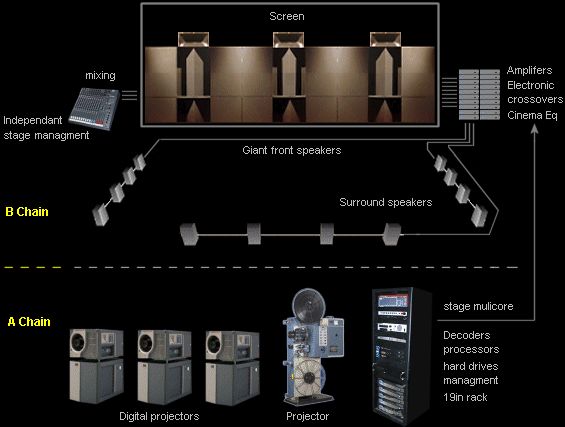Mass entertainment and home entertainment both have their place and are not in conflict with each other. Mass entertainment is ideally suited for productions by exceptional artists where we can collectively enjoy and be inspired by their work being exhibited on a large scale.
The technology for sound system power and fidelity is now unlimited. Digital audio is now available in loss-less format which can achieve a flat response 20Hz - 20KHz with zero distortion or noise. We now have the technology with un-limited building resources to create new projected entertainment centres acoustically free of echoes and reverberation. There should be no need for the X-curve or any other external acoustical equalizing for solving past reverberation problems. The new venues should have exceptionally superior sound by comparison to the present cinemas including live venues and home cinema.
Sound should become 50% of the entertainment experience, where it truly belongs.
There should also be open competition between venues with the latest technological innovations. With digital projection the management formats should be made open architecture, similar to live theatre and live concert productions. This should allow variations in the number of projectors that can be used to create wide screen panoramic experiences similar to the 1950s Cinerama. The ultimate quest being the inevitable arrival of large scale projected 3D.
Satellite technology can transmit live musical concerts or live theatre including Olympic games and other world sports events in real time. Multi-projectors can create wide screen panoramic experience giving the feeling of actually being at the event, with the added value of viewing and hearing greater detail.
This freedom will unleash waves of creative artists and directors competing with innovative productions including real time interactive games with audience participation throughout the world. Ideas that in the past would have been thought of as crazy will invigorate the industry. Independent film creators should be able to negotiate directly with projected entertainment centres for the best facilities and locations to exhibit their work.
Projected entertainment centres should retake the position that traditional commercial cinemas had in past; of being the future leaders of a new Golden era of entertainment.

The B chain will need to be independent, with the amplifiers being placed with the screen speaker system. This will include independent mixing access to be compatible with live entertainment.
This separation of B chain management will enable broadcast type engineering standards to be applied enabling a greater accuracy for sound system alignment, as well as serviceability and easier up-grading if and when required. Another business advantage for full separation of the AB chains is that it will give film distributors independent management and greater security of digital films in the projector room.
Home entertainment of the future
Home entertainment, both visual and musical, naturally follows from the mass entertainment medium. After being exhibited in mass entertainment the material should be available to all of us in 'open format'. Open format should allow us to interact with home computers with extended software to creatively participate as producers and directors from being inspired by the original material presented at mass entertainment exhibitions.
Digital technology enables an openness suited to the home environment where creative expression can be transferred to each generation, which in turn generates new entertainment for the mass medium, exponentially expanding the industry.
Misunderstanding Digital technology is often miss-understood as being thought of as its content, rather than the management or medium by which it is transferred. However there is an understandable overlap between digital content, medium and management, but we should not confuse one with the other. This basic misunderstanding of digital technology is where all corporate confusion and mistakes are made, which results in the golden opportunities that are given to them to administer being lost.
This miss-management of digital technology is driven by Luddite legal advisers and CEOs in their futile attempt to own, possess and control the content, without realising they are restricting access to the medium, which restricts innovation for more content to be created. We can clearly see this in the inept and blind practices of record companies trying to control the content restricting what can be down-loaded, without realising that the technology for down-loading is what could enable their industries to economically thrive.
Two way street Art is made successful by our collective acceptance of it. Therefore the economic return from mass acceptance represents a 50% ownership. Regardless of our individual beliefs, if no one wants to see a movie, it has no value. Art can only be considered creative if it sells, a difficult concept to understand.
Once the material has been exhibited as mass entertainment where the initial economic return is based, the content should be available at low cost to all of us. Once in the hands of the average person in 'open format' that allows for creative interaction, it can then be re-created and competitively re-exhibited for mass entertainment, and again re-valued as creative art. If it is successful from economic reward, then the new art becomes a 2 way street of ownership, continuing the cycle again and again. The royalty structures for shared ownership with dis-encouragement to plagiarise are already in place, but the willingness to allow it is not.
The 'Miserere' composed by Gregorio Allegri 1630s was considered as being given by God exclusive to the Catholic church. This beautiful piece of complex music was performed at the Sistine Chapel by two choirs of nine voices. The 'Miserere' was jealously guarded for over 100 years and was not allowed to be published. It was handed down from choir-master to choir-master under strict supervision and punishable by ex-communication if transcribed. But in 1770 Wolfgang Mozart age 14 heard the piece once and memorised the music. He then made transcriptions freely available to the world for everyone to share and enjoy. How deluded we are to believe anything has changed or that we learn from history.


